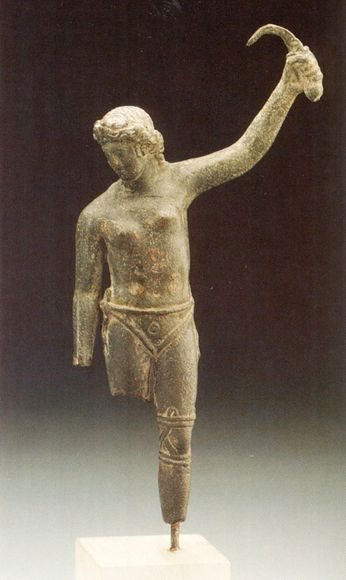Why does the ancient Roman gladiator statue have a strange posture?
Female gladiators are extremely rare images of the ancient Roman empire. However, the results from the study on a statue at the German Museum show that during this period, it was quite common to train women to become warriors in ancient arenas.
The bronze statue is about 2000 years old with the image of a naked woman with only a small piece of cloth wrapped around her waist, her left hand holding a high-posture-like scythe, expert Alfonso Manas from Dai Study Granada (Spain) said.

Ancient Roman female gladiator statue
with strange posture. (Photo: Alfonso Manas)
Manas believed that the object was the Sica sword - the short and curved sword used by Thrace fighters. When fighting, Thrace fighter often wears a helmet with feathers and a small shield, his shin is protected by a metal armor called 'greave' . Their unshielded back would be the target Sica aimed at.
However, before that, many scholars asserted that this curved scythe was 'strigil' , the type of device that the Romans used to cleanse their bodies when bathing.
'So just assume that the girl is bathing, raising it while facing the ground is completely meaningless,' Manas said. Moreover, 'a cloth wrapped around the' sensitive 'area is quite ridiculous because if you take a bath, you will have to remove the entire outfit'.
Meanwhile, the bowing of the head and swinging its arms up like the statue's posture is known to celebrate the typical victory of gladiators in ancient Roman art. At the end of the fight, the winner will remove the helmet so people can see their faces, according to Manas.
More specifically, a rule in the war is that gladiators (whether male or female) must be bare-chested. In addition to fighting duties, the female soldier's bare breasts will be an effective porn tool for audiences, Manas writes in the International Journal of Sports History.
Although these bizarre fights have been repeatedly mentioned in many documents about the ancient Roman world, its specific image is still extremely small.
Reference: Nationalgeographic
- Discover the 'whole vegetable' diet of ancient Roman gladiators
- Mysterious rooster statue in ancient Roman tomb
- Find the ancient Roman statue at the underwater palace
- Gladiator - Roman symbol of sex
- The truth about the 'standard body' of the ancient gladiator
- Found 1,900 year old eagle statue between London
- Occupation as a gladiator in Roman times
- The legend of the gladiator at the Roman villa
- Play strange stone phenomenon in My Son heritage
- Restore the pharaoh statue after 3,200 years
- The project revives wonders of the ancient world
- Compare 7 world wonders in ancient and modern times
 The truth about the mysterious red-haired giant at Lovelock Cave
The truth about the mysterious red-haired giant at Lovelock Cave Inunaki Tunnel: The haunted road leading into Japan's 'village of death'
Inunaki Tunnel: The haunted road leading into Japan's 'village of death' The mystery of the phenomenon of human reflection before dying
The mystery of the phenomenon of human reflection before dying 6 mysterious phenomena, although science has been developed for a long time, still cannot be answered
6 mysterious phenomena, although science has been developed for a long time, still cannot be answered